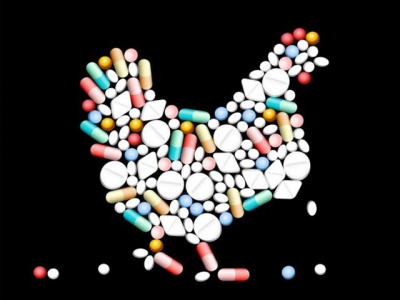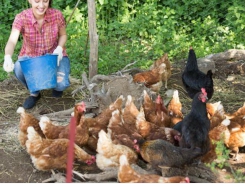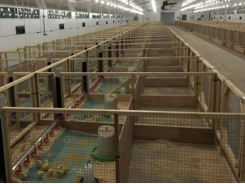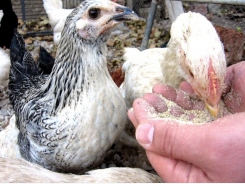Broilers, turkey see fewer antimicrobials at hatch, in feed

The amount of antimicrobials added to the feed and water of broiler chickens and turkeys fell in the US from 2013 to 2017.
The US Poultry and Egg Association released the results of the first report documenting the on-farm use of antimicrobials on Monday [August 5]. The report examined data from broiler chicken and turkey producers and covered 2013 to 2017.
Overall, the project, which had voluntary participation, included information regarding about 90% of broiler chicken production and 80% of the annual turkey production, according to the report authors Randall Singer and Leah Porter, Mindwalk Consulting Group.
However, data collected was not compared to the sales data published in the FDA Sales and Distribution report or extrapolated to the entire US poultry industry – results presented are considered specific to the companies involved in the project.
The period of data collection covered the start of the Veterinary Feed Directive (VFD), which changed how some antimicrobial products could be used in livestock production, they said.
In chickens, the in-feed use of several medically important in human medicine antimicrobials dropped as did use of gentamicin, they said in the report. There was also a shift to the use of antimicrobial products that are not considered medically important.
Similarly, turkey producers documented a decrease in the use of some antimicrobials in the hatchery and in both feed and water, they said.
The data helps provide a valuable baseline, although there are still some limitations to the information, said Karin Hoelzer, senior officer with Pew Charitable Trusts. The organization has been working to improve the collection of data regarding antibiotic use as part of an effort to improve judicious use and stewardship.
“Over the last few years, we’ve seen a dramatic shift in the poultry industry toward raising animals with few or no antibiotics, so we were assuming that there would be a corresponding drop in how many antibiotics were used, but we didn’t have the data,” she told FeedNavigator. “Now we have the data to really understand how it the system has changed antibiotic use practices.”
“When it comes to antibiotic use data, we really are interested in this for two key reasons – the first is it’s important to have antibiotic use data to understand how antibiotics are currently used, where there’s need for research, what the biggest uses and drivers of antibiotic use are and where for instance are alternatives most needed,” she said.
The second reason is that, given the change in regulation and consumer interest in birds raised with limited or no antibiotic use, data is needed to determine the influence of those trends.
The new report highlights some of the challenges remaining for producers and it could be used to help focus research efforts addressing bird health, she said.
Antibiotic use in broilers, turkey production
Data collected on chicken production tracked birds from the hatchery to slaughter, said the report authors. By 2017, the data gathered on broilers included about 93% of the US broiler production and data gathered on turkey production included about 82% of annual turkey generation or more than 164,000,000 turkeys.
Data was audited by the Center for Epidemiology and Animal Health at the US Department of Agriculture (USDA).
“For both the broiler chicken and turkey industries, large reductions were observed in antimicrobial use over the five-year period,” the authors said. “While a reduction in antimicrobial use may be an important indicator of improved stewardship, reducing the need for antimicrobials through improved disease prevention should be considered a more holistic indicator of overall flock health and optimal antimicrobial use.”
Antimicrobial use in broilers primarily targeted diseases including necrotic enteritis, colibacillosis and gangrenous dermatitis, they said. Turkey producers turned to antimicrobial use to target gangrenous dermatitis, bacterial enteritis and colibacillosis.
Use of antimicrobial products in the hatchery fell from 2013 to 2017, they said. During that period, the approximate percentage of chicks that received an antimicrobial dropped from 93% to 17%.
The use of gentamicin in the hatchery fell by about 74%, they added.
During production, the use of virginiamycin in feed fell by about 60%, while in-feed use of tetracycline decreased by about 95%, the authors said. Additionally, the in-feed use of tylosin stopped in 2017 following the change in approved uses of the drug as provisions of the VFD started.
Several water-based antimicrobials also saw use decline including penicillin, tetracycline, lincomycin, sulfonamide and tylosin.
Turkey producers also cut their use of antimicrobials in the hatchery as the percentage of turkey poults that received antimicrobials during that time fell from 96% to 41%, the authors reported. Gentamicin use at that stage fell 42% and ceftiofur use ceased.
Producers trimmed their feeding of tetracycline 67% and the in-water use of penicillin, tetracycline, lincomycin, neomycin and erythromycin, they noted. The in-feed use of virginiamycin and tylosin also stopped for turkeys based on regulatory changes.
However, the use of water-soluble tylosin increased about 275%, florfenicol use expanded by about fivefold while trimethoprim and spectinomycin use grew for turkey producers, they said. The use of bambermycin in turkey feed also expanded.
Chickens saw a shift to the use of antimicrobial drugs considered not medically important for humans, they said. In broilers, the shift meant that the addition of avilamycin to feed increased in 2017 to prevent necrotic enteritis, while the use of bacitracin in feed remained prevalent.
Bambermycin use in feed also increased from 2013 through 2016, but it fell slightly in 2017, they added.
Need for more information
The hope behind gathering information on antibiotic use in poultry, or livestock, would be to develop new management practices, alternative therapies or other approaches to improve animal health without the reliance on antibiotic use, said Hoelzer.
However, there are still some challenges to data collection that have to be addressed, she said. There is ongoing debate about what are the best metrics to report information like antibiotic use.
There is also interest in some more “granular” data regarding areas like the duration of use for the antibiotic products and if the use was effective, she said.
“One limitation was that they really focused on large producers for a variety of reasons – it would be important to get some insight into some of the smaller producers that might have had different health problems to deal with, or that might have different types of operations,” she added.
“One thing that the report did talk about in detail was the change in data availability over the time period from when the project was started and some of the data had to be analyzed retrospectively which is more challenging,” Hoelzer said. “One effect of this research project was the establishment of newer, better, more detailed data collection systems that will provide more of that information going forward – that is important to keep in mind that the data is becoming more granular and richer because there is an impetus to collect and report the data.”
Related news
Tools

Phối trộn thức ăn chăn nuôi

Pha dung dịch thủy canh

Định mức cho tôm ăn

Phối trộn phân bón NPK

Xác định tỷ lệ tôm sống

Chuyển đổi đơn vị phân bón

Xác định công suất sục khí

Chuyển đổi đơn vị tôm

Tính diện tích nhà kính

Tính thể tích ao




 Black UV light may improve poultry house air…
Black UV light may improve poultry house air…  Post-hatch feed and broiler performance
Post-hatch feed and broiler performance